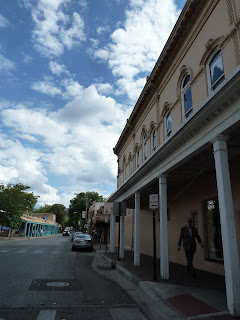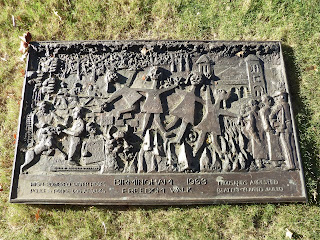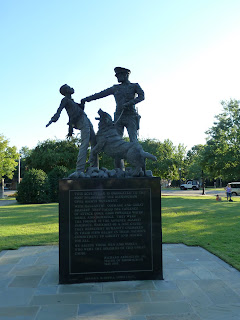Drive from Tupelo, MS to Little Rock, AR
Hot Springs National Park
 “Nothing but a row of bathhouses”--that was how we had heard the smallest national park described. And indeed, Hot Springs National Park is simply one side of the downtown street, nothing more than a collection of buildings in which tourists bathe. Bizarre? Oh yes.
“Nothing but a row of bathhouses”--that was how we had heard the smallest national park described. And indeed, Hot Springs National Park is simply one side of the downtown street, nothing more than a collection of buildings in which tourists bathe. Bizarre? Oh yes. To be fair, the architecture of the bathhouses is quite interesting. Even the names themselves are quite curious. But what dominated my mind was the sheer lavishness of a building and an entire process of bathing, massaging, and pampering. I suppose these places preceded the current spa and therefore for some are not so outlandish.As for the supposed healing qualities of the water from the springs? That aspect angered me greatly. Falsely marketing water as magical in some way, preying on the sickly and wealthy—that seems unconscionable. But perhaps I am oversimplifying the issue.
To be fair, the architecture of the bathhouses is quite interesting. Even the names themselves are quite curious. But what dominated my mind was the sheer lavishness of a building and an entire process of bathing, massaging, and pampering. I suppose these places preceded the current spa and therefore for some are not so outlandish.As for the supposed healing qualities of the water from the springs? That aspect angered me greatly. Falsely marketing water as magical in some way, preying on the sickly and wealthy—that seems unconscionable. But perhaps I am oversimplifying the issue. A quick poke around was all we needed to get an idea of the national park. The most interesting part for me was chatting with the cute park ranger, Mr. Madison, who revealed to us that he is single and looking, but that the National Park Service sadly has the second highest divorce rate of any federal agency, right behind the CIA. He also proved himself not to be ageist and bestowed upon me a Junior Park Ranger badge.
A quick poke around was all we needed to get an idea of the national park. The most interesting part for me was chatting with the cute park ranger, Mr. Madison, who revealed to us that he is single and looking, but that the National Park Service sadly has the second highest divorce rate of any federal agency, right behind the CIA. He also proved himself not to be ageist and bestowed upon me a Junior Park Ranger badge.
Upon the advice of the ranger, we stopped by Happy Hollow Spring to fill up. The water was pure, if different, largely due to its unique mineral content. People came from all over with great assortments of water containers to fill up from the spring free of charge. The National Park Service assures us that it is indeed our park and therefore our water, and we are encouraged to benefit from the springs. But how much longer will this resource last, I wonder. The premise for Urinetown comes to mind. 
A blast of country music and some more Tolkien ushered us into Tulsa, Oklahoma as the sun began to set. We were so pressed for time that we had bypassed Little Rock altogether (though sadly not its traffic) and therefore were unable to visit Little Rock's Central High, home of the Little Rock Nine, the nine African American students that began the integration process in the South. Initially the state governor ordered in his troops to prevent the students from entering the building, supported by a riotous mob of indignant white folks. The federal government finally intervened, and the students were flanked by the National Guard, overruling the local government once more. Those images of those incredibly courageous young teens break my heart every time I see them. What unfathomable bravery. What unfailing character. What incredible forgiveness. 
It was late and lest we completely disrupt the sleeping schedule of the friends we were to meet, we opted for spending the night in yet another delightful state park: Tombigbee State Park. Really. Tombigbee.




























